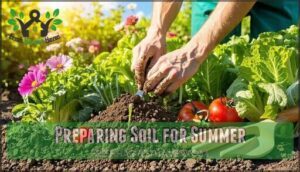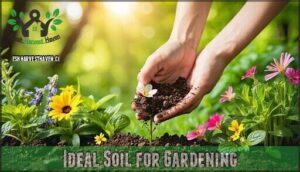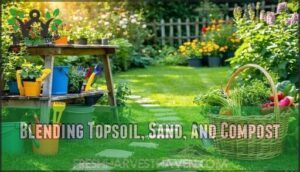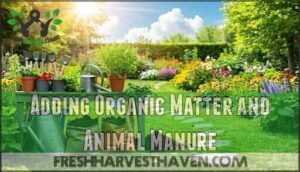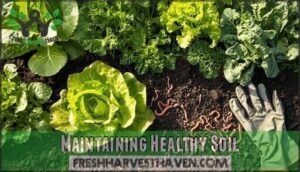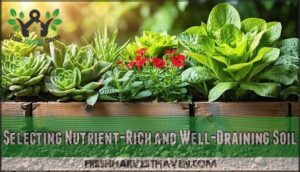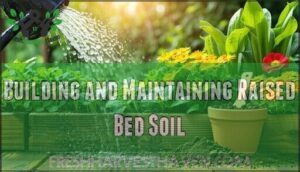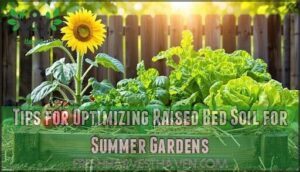This site is supported by our readers. We may earn a commission, at no cost to you, if you purchase through links.
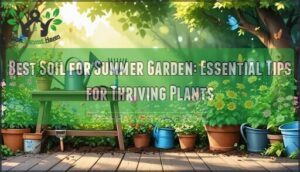
This golden combination holds moisture without waterlogging your plants’ roots while providing essential nutrients.
Aim for a pH between 6.0-7.5 to maximize nutrient uptake.
Think of quality soil as your garden’s foundation – without it, even the most expensive fertilizers won’t deliver results.
Mix in 2-3 inches of aged compost to feed beneficial microbes that’ll work around the clock for your plants.
The secret lies in creating soil structure that breathes, and understanding that well-draining properties are key to a healthy garden.
Table Of Contents
- Key Takeaways
- Soil Composition Matters
- Essential Plant Nutrients
- Preparing Soil for Summer
- Ideal Soil for Gardening
- Creating Perfect Soil Mix
- Maintaining Healthy Soil
- Raised Bed Soil Considerations
- Frequently Asked Questions (FAQs)
- What is the best soil for an outdoor garden?
- What is the best soil to use in garden beds?
- What is the best soil for summer vegetables?
- How to prepare soil for summer vegetables?
- What is the best soil mix for a vegetable garden?
- When should I start preparing summer garden soil?
- How deep should summer vegetable roots grow?
- Can I reuse last years potting soil mix?
- What causes white mold on garden soil surface?
- Should I cover soil during summer heat waves?
- Conclusion
Key Takeaways
- You’ll need well-draining loamy soil that balances sand, silt, and clay particles to prevent waterlogging while retaining essential moisture and nutrients your summer plants crave.
- Mix in 2-3 inches of aged compost annually to feed beneficial soil microbes and create a living ecosystem that naturally supplies nutrients throughout the growing season.
- Maintain soil pH between 6.0-7.5 through regular testing to maximize nutrient uptake and prevent deficiencies that can sabotage your harvest.
- Prepare your soil 4-6 weeks before planting by clearing debris, loosening compaction 8-12 inches deep, and adding organic matter to create the foundation for summer success.
Soil Composition Matters
Your soil’s foundation determines everything that grows above it.
Understanding what makes soil work—from tiny mineral particles to bustling microbial communities—gives you the power to create an environment where summer plants don’t just survive, they absolutely thrive.
Minerals and Organic Matter
Your soil’s mineral composition—the blend of clay particles, sand, and silt—forms your garden’s backbone.
Organic matter transforms this foundation into something magical. Here’s what happens when they team up:
- Clay particles hold nutrients like tiny treasure chests
- Organic compost feeds beneficial microbes that release plant food
- Loam creates the perfect balance for root growth and water flow
This partnership between mineral particles and soil organic matter determines your soil texture and growing success.
Living Organisms and Water Content
Picture billions of tiny workers building your garden’s underground metropolis.
Your soil’s underground army works 24/7 transforming scraps into plant gold
These soil microorganisms need perfect water retention balance – about 50% moisture and air combined.
Microbial activity transforms nutrients while earthworms boost soil porosity.
Your summer watering feeds both plants and this bustling ecosystem of soil microbes, creating ideal moisture levels for thriving organic matter decomposition.
Ideal Soil Texture and Structure
Beyond minerals and organic matter, you need to understand how these components work together to create the perfect growing environment.
Soil texture determines everything about your garden’s success. Well-draining loamy soil combines sand, silt, and clay in perfect harmony. This creates ideal soil porosity and pore space for air and water movement.
Aggregate stability keeps your soil structure intact, while proper soil density guarantees easy root penetration.
Your plants thrive when soil composition provides:
- Water retention without waterlogging that kills roots
- Adequate aeration that prevents suffocating plant systems
- Stable structure that won’t compact under pressure
Essential Plant Nutrients
You’ll want to understand what nutrients your plants actually need before you start mixing soil.
Think of these nutrients as your garden’s grocery list – without the right ingredients, even the best soil structure won’t help your plants thrive.
Primary Nutrients for Plant Growth
Master these three powerhouse nutrients to transform your summer garden soil into a plant paradise. Your crops demand specific nitrogen, phosphorus, and potassium levels for peak performance during growing season.
Understanding nitrogen function, phosphorus roles, and potassium benefits prevents costly nutrient deficiencies that sabotage harvests. Garden soil nutrients work together like teammates – when one’s missing, the whole system suffers. One way to avoid these deficiencies is by fertilizing vegetable plants naturally.
- Nitrogen – Fuels explosive leaf growth and lush green foliage development
- Phosphorus – Powers strong root systems and abundant flower production
- Potassium – Strengthens disease resistance and enhances fruit quality
- Balanced fertilizer types – Deliver steady nutrition without overwhelming plants
Secondary Macronutrients and Micronutrients
Your plants need more than just NPK to thrive.
Great gardens demand more than NPK—micronutrients and minerals fuel your plants’ true summertime potential
Calcium importance shows in strong cell walls, while magnesium uptake powers chlorophyll production.
Sulfur benefits protein synthesis, and iron chelation prevents yellowing leaves.
Watch for calcium deficiency in blossom end rot and boron deficiency causing poor flowering—these soil nutrient deficiencies can derail your garden despite perfect primary nutrients.
Role of Nitrogen, Phosphorus, and Potassium
NPK nutrients form your summer garden soil’s power trio. Understanding their roles transforms struggling plants into thriving ones.
- Nitrogen functions fuel vigorous leaf growth and deep green color, but deficiency symptoms show up as yellowing foliage
- Phosphorus functions develop strong root systems and abundant blooms, critical for flowering plants
- Potassium functions boost disease resistance and improve fruit quality throughout the growing season
Balanced fertilizer ratios in your best garden soil create ideal growing conditions for summer success.
Preparing Soil for Summer
Getting your summer garden ready starts with proper soil preparation that sets the foundation for thriving plants.
You’ll need to clear debris, loosen compacted soil, and add organic matter to create the perfect growing environment your vegetables and flowers need to flourish in the heat.
Clearing Debris and Loosening Soil
From start to finish, clearing debris and loosening soil sets your summer garden up for victory. Begin with Debris Removal – pull rocks, sticks, and trash that block healthy root development. Weed Control comes next, eliminating nutrient thieves before they establish deeper root systems.
Soil Aeration requires digging 8-12 inches deep using proven Tilling Techniques. Break compacted earth with a broadfork or spade for effective Compaction Relief. This creates better Soil Tilth – that crumbly texture plants love.
Your garden soil preparation isn’t complete without testing drainage. Pour water into your prepared area and watch how quickly it absorbs. Proper Aeration Techniques guarantee roots get oxygen while preventing waterlogged conditions that kill plants.
Task Tool Depth/Method
Quality summer garden soil starts with thorough clearing debris and proper soil structure.
Adding Compost and Aged Manure
You’re releasing your garden’s potential with nature’s best amendments. Spread 2-3 inches of aged manure and compost across your bed, then work these nutrient powerhouses into the top 6-8 inches of soil.
This organic gold boosts microbial activity while delivering slow-release nutrients that’ll feed your summer crops for months. Consider buying aged manure for superior soil enrichment.
Compost Benefits and Application Techniques:
- Aged manure provides 0.5-1.0% nitrogen content for steady plant nutrition
- Compost doubles soil microbes within six weeks, creating a living ecosystem
- Organic matter increases water retention by 10-20%, reducing irrigation needs
- Soil amendments prevent nutrient leaching by 30-50% through improved binding
- Summer garden soil thrives with proper nutrient release from these natural fertilizers
Leveling and Raking The Garden Bed
Achieving proper surface preparation transforms your amended soil into the perfect seedbed creation foundation. Smart tool selection makes this essential step effortless rather than backbreaking work.
Your soil consolidation efforts determine whether plants thrive or struggle through summer heat.
Here’s your step-by-step approach:
- Use proper raking techniques – A landscape rake’s wide tines break up clumps while creating uniform soil consolidation across your garden bed
- Create subtle drainage gradient – Build a gentle crown that’s 2-3 inches higher at center than edges for natural water flow
- Target problem areas – Fill depressions and remove any remaining debris that escaped your initial clearing debris phase
Quality leveling tools make this job surprisingly quick. You’re creating the ideal seedbed that’ll support strong root systems and prevent waterlogged conditions that kill summer vegetables.
Ideal Soil for Gardening
You’ll find that loamy soil consistently delivers the best results for summer gardens because it perfectly balances drainage, moisture retention, and nutrient availability.
This ideal soil combination creates the foundation your plants need to handle summer’s heat while maintaining steady growth and vibrant health.
Characteristics of Loamy Soil
Loamy soil delivers the perfect foundation your summer garden needs.
This welldraining loamy soil contains equal parts sand, silt, and clay in its loam composition, creating ideal porosity for root growth.
The balanced loam texture guarantees excellent water retention while preventing waterlogging, maintaining consistent nutrient availability throughout hot months.
Rich microbial activity thrives in this soil structure, while aggregate stability prevents erosion and compaction.
| Property | Benefit |
|---|---|
| Ideal Porosity | Allows roots to breathe and spread easily |
| Water Retention | Maintains moisture without drowning plants |
| Aggregate Stability | Resists compaction during heavy summer watering |
| Microbial Activity | Supports beneficial organisms that feed plants |
Benefits of Balanced Soil PH
Balanced soil pH creates the perfect chemical environment for your summer garden to flourish.
When soil pH sits between 6.0-7.5, nutrient availability skyrockets as phosphorus, nitrogen, and potassium become readily accessible to plant roots. Microbial activity thrives in this sweet spot, breaking down organic matter efficiently while beneficial bacteria multiply rapidly.
Regular soil testing prevents soil nutrient deficiencies before they stunt plant health. Soil pH directly influences plant health and growth.
Smart gardeners use lime for acidic conditions or sulfur for alkaline soils during soil pH adjustment.
- Enhanced nutrient uptake – Plants absorb fertilizer 40% more efficiently at ideal pH
- Stronger root development – Balanced acidity prevents aluminum toxicity that damages roots
- Improved microbial communities – Beneficial bacteria flourish, suppressing harmful pathogens naturally
- Better water retention – Proper pH maintains soil structure for optimal growth conditions
- Reduced pest problems – Healthy plants with adequate nutrition resist disease and insect damage
Importance of Good Drainage and Aeration
Good drainage and soil aeration prevent root suffocation and maintain healthy microbial life. Poor drainage causes root rot, while soil compaction blocks oxygen flow that plants desperately need.
Think of soil as your garden’s lungs – without proper airflow, everything suffocates. Here’s how to improve drainage improvement and optimize water retention:
- Add coarse sand or perlite to heavy clay soils
- Layer organic compost to create natural air pockets
- Build raised beds for superior soil drainage control
Proper aeration transforms struggling gardens into thriving ecosystems where roots breathe freely and plant health flourishes.
Creating Perfect Soil Mix
Creating the perfect soil mix for your summer garden isn’t rocket science, but it does require understanding the right proportions and ingredients.
You’ll want to combine specific ratios of topsoil, compost, and amendments to achieve the ideal balance of drainage, nutrients, and moisture retention that summer plants crave.
Blending Topsoil, Sand, and Compost
Creating your perfect garden soil mix requires precise blending ratios for superior results.
The ideal formula combines 40% topsoil, 30% sand, and 30% compost by volume.
This blend delivers exceptional drainage improvement while maintaining vital water retention.
| Component | Percentage | Benefits |
|---|---|---|
| Topsoil | 40% | Provides minerals, soil structure |
| Sand | 30% | Enhances drainage improvement |
| Compost | 30% | Boosts nutrient availability |
| Mixed Depth | 8+ inches | Supports root development |
| pH Range | 6.5-7.2 | Optimizes plant uptake |
Mix these garden soil amendments thoroughly until you achieve uniform texture.
Quality topsoil supplies essential minerals, while coarse sand prevents waterlogging.
Rich compost transforms this vegetable garden soil into a thriving ecosystem.
A balanced mix also requires adequate soil porosity to guarantee proper aeration.
This garden soil mix reduces fertilizer needs by 30-45% compared to single-component alternatives, creating the foundation for your summer garden success.
Adding Organic Matter and Animal Manure
Once your basic mix is ready, organic matter and aged manure become your soil’s secret weapons for summer success.
Fresh manure burns plants, but aged varieties release nutrients slowly while building structure. Cow manure provides balanced nutrition, while worm castings pack concentrated nutrients that soil microbes love.
Here’s your organic matter blueprint:
- Apply 2-3 inches of aged manure – cow, horse, or composted chicken work best
- Mix in finished compost for immediate microbial activity and nutrient cycling
- Add worm castings at 10-20% of your total mix for premium nutrition
- Include green manures like alfalfa meal for slow-release nitrogen
- Blend thoroughly to distribute organic matter evenly throughout your soil
These amendments create living soil ecosystems that feed plants naturally all season long. Using aged cow manure products can enhance soil fertility and structure.
Achieving Optimal Soil Moisture and Structure
Perfect soil structure feels like damp chocolate cake when squeezed, then crumbles apart easily.
This balance prevents soil compaction while maintaining ideal moisture levels.
Add perlite to heavy mixtures for better drainage systems and soil aeration.
Your organic garden soil should breathe freely while retaining water efficiently through proper soil amendments and composition management, ensuring ideal moisture levels.
Maintaining Healthy Soil
You’ve built the perfect soil foundation, but maintaining its health is what separates thriving summer gardens from struggling ones.
Think of soil as a living ecosystem that needs regular care and attention, not a static growing medium you can ignore once plants are in the ground.
Adding Compost and Organic Matter Regularly
Your soil becomes a living, breathing ecosystem through consistent organic feeding.
Think of compost benefits as investment returns – each addition compounds over time. Regular organic matter creates nutrient cycling powerhouses that transform kitchen scraps into plant fuel. Your garden’s microbial growth depends on steady meals.
Here’s your feeding schedule:
- Spring preparation – Apply 2-3 inches of organic compost before planting
- Mid-summer boost – Layer grass clippings and composted manure lightly
- Fall enrichment – Work aged materials into soil organic matter
- Winter protection – Top-dress beds with humus formation materials
Smart compost ratios maintain soil enrichment without overwhelming your plants’ root systems. Understanding soil health basics is essential for creating a thriving garden ecosystem.
Avoiding Over-Amending and Compaction
Beyond the temptation to "feed" your soil lies the danger of soil compaction and overamending. Too much organic matter creates soil density problems that hurt root health.
Smart gardeners avoid these pitfalls:
- Over fertilizing turns beneficial amendments into suffocating blankets
- Garden drainage fails when soil becomes waterlogged from excess materials
- Soil aeration decreases as soil structure becomes overly dense
Keep soil amendments to 25% of your mix. Walk on pathways, not beds. Work moist soil only.
Monitoring Soil Health and Adjusting Strategies
Regular soil testing keeps your summer garden performing at peak levels.
Test soil pH and soil nutrients annually, checking soil moisture management monthly during growing season.
Monitor microbial balance through visual cues like earthworm activity and organic matter breakdown.
Adjust fertilizer optimization based on test results.
Poor drainage signals compaction prevention needs.
Track these indicators for ideal soil health:
| Monitoring Task | Frequency | Action Required |
|---|---|---|
| Nutrient Cycling | Annual | Adjust fertilizer ratios |
| Soil pH levels | Every 2 years | Add lime or sulfur |
| Moisture content | Monthly | Modify irrigation schedule |
| Microbial activity | Seasonal | Add compost or organic matter |
| Compaction signs | Before planting | Aerate and add amendments |
Smart gardeners track these metrics like checking their bank account – regularly and with purpose.
Raised Bed Soil Considerations
Raised beds offer complete control over your soil environment, but they present unique challenges that standard garden plots don’t face.
You’ll need a specialized soil mix that balances drainage with moisture retention since raised beds drain faster and heat up quicker than ground-level gardens, requiring a mix that provides moisture retention.
Selecting Nutrient-Rich and Well-Draining Soil
Why settle for mediocre soil when your raised bed deserves premium nutrition? Quality soil transforms your summer garden from surviving to thriving.
Essential characteristics of nutrient-rich, well-draining soil:
- Rich chocolate-brown color indicating abundant organic matter and ideal nutrient balance for robust plant growth
- Crumbly, friable texture that maintains structure while allowing proper drainage systems to prevent waterlogging
- Fresh, earthy aroma suggesting healthy soil pH levels and active nutrient cycling from beneficial microorganisms
- Balanced moisture retention supporting summer gardening tips while avoiding compaction that restricts root development
Soil testing reveals whether your chosen mix meets these standards before planting begins. For superior results, consider a Garden Soil Mix that enhances soil structure and fertility.
Building and Maintaining Raised Bed Soil
Creating your raised bed soil starts with the right Raised Bed Mix—combine equal parts topsoil, compost, and coarse sand.
Bed Preparation includes loosening existing soil eight inches deep for proper Soil Aeration.
Feed monthly with Compost Tea during growing season.
Add Mulch Layers to retain moisture and suppress weeds.
Test soil pH annually for ideal raised garden beds performance.
Tips for Optimizing Raised Bed Soil for Summer Gardens
Your raised bed soil thrives with strategic summer adjustments. Start by checking soil temperature regularly—it shouldn’t exceed 85°F for ideal root health. Maintain proper bed depth of 8-12 inches to protect roots from heat stress.
Summer mulch acts like a protective blanket, keeping your raised bed soil cool and moist. Apply 2-3 inches of organic mulch around plants, leaving space near stems to prevent rot. This simple step cuts watering needs by half.
Test your soil monthly during summer’s peak. pH levels can shift with increased watering and heat stress. Adjust amendments based on results—your plants will thank you.
- Monitor soil temperature daily during heat waves using a probe thermometer
- Apply summer mulch strategically around plants while avoiding direct stem contact
- Conduct regular soil testing to track nutrient levels and pH changes throughout the growing season
Effective summer gardening techniques are vital for maintaining healthy plants. Your best soil for summer garden success starts with these practical steps for raised bed gardening excellence.
Frequently Asked Questions (FAQs)
What is the best soil for an outdoor garden?
Loamy soil works best for outdoor gardens. You’ll want equal parts sand, silt, and clay mixed with compost. This combination drains well, holds nutrients, and lets roots breathe easily.
What is the best soil to use in garden beds?
You’ll want loamy soil that combines sand, silt, and clay in balanced proportions.
This golden mix retains moisture while draining excess water, preventing root rot and promoting healthy growth in your beds.
What is the best soil for summer vegetables?
Summer vegetables thrive in well-draining loamy soil enriched with compost.
You’ll want a balanced mix of sand, silt, and clay that retains moisture while preventing waterlogging, ensuring your plants get ideal nutrition and root development, with well-draining soil being crucial.
How to prepare soil for summer vegetables?
Clear debris and loosen compacted soil 8-12 inches deep.
Add 2-3 inches of compost or aged manure to enrich nutrients and structure.
Level and rake for even distribution and proper drainage.
What is the best soil mix for a vegetable garden?
Think of soil as your garden’s foundation – like building blocks that determine everything above.
You’ll want equal parts quality topsoil, rich compost, and aged manure for vegetables.
This trinity creates perfect drainage while retaining nutrients your plants crave.
When should I start preparing summer garden soil?
Start preparing your soil 4-6 weeks before your last frost date. This timing allows organic amendments like compost to integrate and soil structure to improve before planting season arrives.
How deep should summer vegetable roots grow?
Most vegetable roots penetrate 12-24 inches deep, though they’ll spread wider than downward. You’ll need loose, well-draining soil at least 18 inches deep for ideal growth and nutrient access.
Can I reuse last years potting soil mix?
Like breathing new life into tired shoes, you can absolutely refresh last year’s potting mix with some TLC.
Add fresh compost and check for compaction, salt buildup, or pest eggs before reusing it this summer.
What causes white mold on garden soil surface?
White mold on garden soil surfaces typically develops from excessive moisture, poor air circulation, and decomposing organic matter.
You’ll often see this fuzzy growth when soil stays too wet or lacks proper drainage and ventilation.
Should I cover soil during summer heat waves?
Scorching heat waves can absolutely devastate your precious garden soil.
You should definitely cover it with mulch, shade cloth, or row covers to prevent moisture loss and temperature spikes that damage beneficial microorganisms and soil structure, including temperature spikes.
Conclusion
Apparently, your summer garden dreams don’t need to involve buying expensive miracle soils that promise instant tomato perfection.
Creating the best soil for summer garden success requires understanding basic soil science and consistent maintenance practices.
You’ll achieve ideal plant growth by focusing on well-draining loamy soil with proper pH balance, regular compost additions, and adequate aeration.
Remember that healthy soil feeds beneficial microorganisms that work continuously to support your plants throughout the growing season, which is key to summer garden success.
- https://yardandgarden.extension.iastate.edu/faq/what-would-be-good-soil-mix-raised-bed
- https://cropnuts.com/soil-ph-and-nutrient-availability/
- https://icl-growingsolutions.com/en-us/agriculture/knowledge-hub/balancing-the-economy-of-soil-ph/
- https://www.horiba.com/usa/water-quality/applications/agriculture-crop-science/soil-ph-and-nutrient-availability/
- https://extension.oregonstate.edu/news/why-soil-ph-matters-how-manage-it-your-garden


